THE CLASSIC HORROR FILM
By Jeffrey-Baptiste Tarlofsky
By Jeffrey-Baptiste Tarlofsky
Lesson 15 consists of 7 video lectures and transcripts of those lectures, and 7 film excerpts. Start with the lecture, Part 1, and continue down the page in sequence until you reach the end of the lesson.
レッスン15は7本のビデオレクチャー(レクチャーのテキストがビデオレクチャーの下に記載されています)と7本の動画で構成されています。
このレッスンは、ページをスクロールダウンしながら最初から順番に動画を見たりテキストを読んでください。
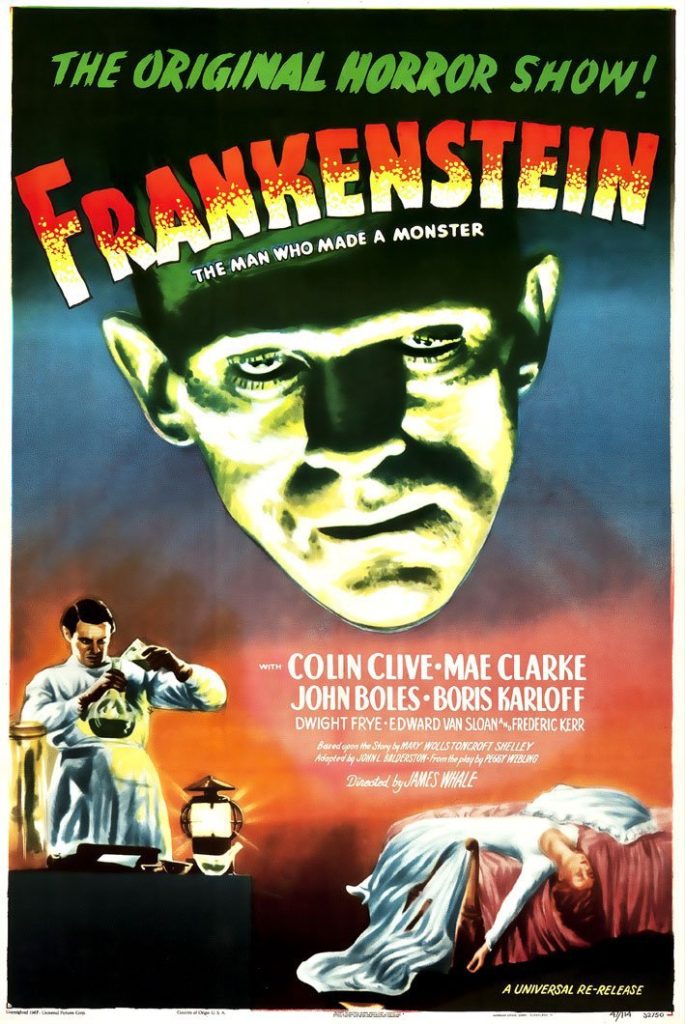
Directed by James Whale
Produced by Carl Laemmle Jr.
Written by Francis Edward Faragoh, Garret Fort based on the play by Peggy Webling and the novel by Mary Shelley
Starring Boris Karloff, Colin Clive, Edward Van Sloane and Dwight Frye
Budget: $265,000
Running Time: 71 minutes
Part One – Mary Shelley gave her novel, Frankenstein, the subtitle “The New Prometheus”; your homework was to find out about the Myth of Prometheus. As you discovered, the story comes to us not from the Judeo-Christian tradition, but from the mythology of ancient Greece. The Greeks believed in many gods rather than just one. Their gods were personifications of certain aspects of the physical world and certain human qualities. For example, Apollo was the god of the sun, but also of music, poetry and dance. Athena was the goddess of wisdom but also goddess of war and protector of the City of Athens.

Apollo
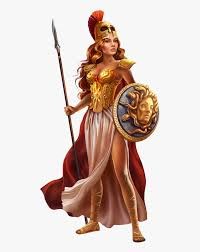
Athena
Prometheus, however, was not a “god” but a “titan” or giant (sometimes said to be the “original gods” or “lesser or demi-gods”). Prometheus is often credited with being the creator of mankind, which he formed from clay. He is known as “the thief of fire” because the King of the Gods, Zeus (the God of Lightning), had forbidden any god or titan from giving mankind fire. Zeus feared that with fire mankind would be able to challenge the gods. However, Prometheus saw that man was cold and afraid of the beasts and ate his food raw. He stole fire and gave it to man so that he would be warm, unafraid and able to cook his food. In other words, he gave man the basis for building human civilization.
In the Myth of Prometheus fire symbolizes “knowledge” just as the fruit in the Biblical book of Genesis also represented knowledge. In both tales this knowledge was forbidden to mankind and the penalty for stealing that knowledge is indeed terrible In the Bible, God punishes Adam and Eve by casting them out of the Garden of Eden and condemning them to eventual death (in the garden they had been immortal).
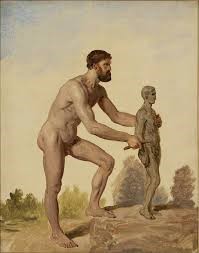
Prometheus

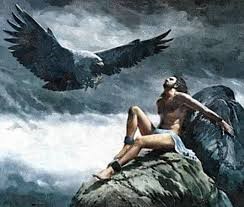
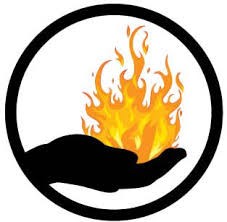
Zeus punishes Prometheus by chaining him to a mountain where every morning a great eagle (symbol of Zeus) comes to him and pecks out his liver. At night the liver grows back so that the same torture can be repeated the next day and so on for eternity.
For the writers of the Romantic period (circa 1800-1850) such as William Wordsworth, Samuel Taylor Coleridge, John Keats, Lord Byron, Percy Bysshe Shelley and Mary Shelley (who was married to Percy, and close friends with Lord Byron), The Prometheus Myth represented the quest for scientific knowledge (which was rapidly progressing at this time)….with all its accompanying risks and dangers. As a character, Prometheus was associated with the idea of the “lonely genius” (something most of these poets and writers believed themselves to be) striving to help humanity. However, the lonely genius also tends to have a self-destructive quality as well. This is almost a perfect description of Frankenstein both in the book and also the film. Listen again to Dr. Waldman’s warning to Frankenstein.
Part Two – Frankenstein says he wants to know what “changes the darkness into light”, but anyone could have told him that if he wanted to know this all he had to do was open the Bible to the book of Genesis where it says God speaks (or thinks or imagines) “light” and so changes the darkness into light. But that isn’t what Frankenstein means. He wants to know how to do it so that he can do it too. Mary Shelley clearly had the Myth of Prometheus foremost in her mind when she wrote her novel because Prometheus is not only the creator of mankind, but also the thief of fire — the one who teaches man how to use fire. The Greeks understood that the gods existed only if people believed in them. Once man mastered fire and began to master the various arts and sciences that come with civilization, he would have reason to doubt the existence of the gods. Zeus was right. Man does challenge the gods. In Mary Shelley’s time that challenge was being made by the study of science. Many of the old taboos are being challenged by new scientific discoveries.
We have already talked about “universal taboos”, so we know that “universal” means common to all cultures as, for example, the taboos against leaving the dead uncared for or against cannibalism were universal. But there are also things that are almost universally thought to have the same symbolic meanings in all cultures. Light, for example, is associated with life, goodness, God or the gods and knowledge in virtually all cultures. Similarly, darkness is associated with death, evil, Satan or evil spirits and ignorance in almost all cultures. Fire, which also brings light, is somewhat more complex but is also usually associated with life, knowledge, imagination and creativity, although it can also be associated with destruction, pain and punishment (as in the fires of Hell).
From the very opening scene of Frankenstein, James Whale is constantly using fire or light symbolically.

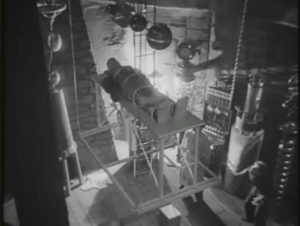
We have already talked about “universal taboos”, so we know that “universal” means common to all cultures as, for example, the taboos against leaving the dead uncared for or against cannibalism were universal. But there are also things that are almost universally thought to have the same symbolic meanings in all cultures. Light, for example, is associated with life, goodness, God or the gods and knowledge in virtually all cultures. Similarly, darkness is associated with death, evil, Satan or evil spirits and ignorance in almost all cultures. Fire, which also brings light, is somewhat more complex but is also usually associated with life, knowledge, imagination and creativity, although it can also be associated with destruction, pain and punishment (as in the fires of Hell).
From the very opening scene of Frankenstein, James Whale is constantly using fire or light symbolically.
William K. Everson, the great film critic, has pointed out that the gravedigger has brought “the spark of life into this place of the dead”. In the very next scene we see that Elizabeth keeps a candle burning in front of the photograph of her fiancée, Henry, about whom she is so worried. Candles or fires are lit for someone as an offering to God or the gods in order to ask for good fortune or protection.
Recall that Prometheus steals fire from the gods, but it was Zeus, God of Lightning, who told the other gods and the titans not to do this. Most anthropologists would agree that the most likely way man really did acquire fire was from lightning causing a fire by striking a tree in a storm. Frankenstein’s “great ray of life” is captured from the lightning storm through his machinery.
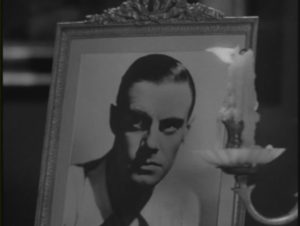
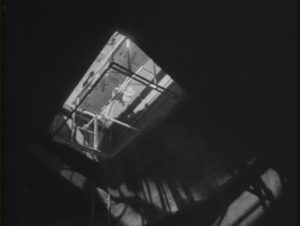
Part Three – In remembering how she thought up the idea for Frankenstein, Mary Shelley wrote about what most terrified her: “Frightful must it be; for supremely frightful would be the effect of any human endeavor to mock the stupendous mechanism of the creator of the world”. To Shelley the idea that a mere human would attempt to do what only God had done before was frightful, indeed horrifying. It violated one of the strongest taboos in the Judeo-Christian-Islamic tradition and was considered the most serious sin of all, blasphemy. Blasphemy is to mock or insult God through words or deeds. The seriousness of “blasphemy” is hard for Japanese to understand because there simply is no corresponding concept in either Shinto or Buddhism. In Japan one can certainly can break the rules of Shinto or Buddhism or pollute or violate the sacred, but blasphemy depends on the idea of a God who will take personal offense. By discovering (i.e., stealing) God’s secret (what changes darkness into light), Frankenstein is like Prometheus, the thief of fire, or Adam and Eve who stole the forbidden fruit from the Tree of Knowledge. But even worse, Frankenstein then uses that forbidden, stolen knowledge to do what only God had done before, create life. That is blasphemy.
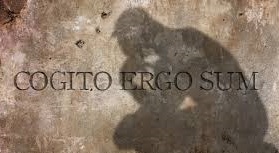 For thousands of years the penalty for blasphemy was death. But in Europe, with the coming of The Enlightenment (which some date from René Descartes’ 1637 Cogito, ergo sum (“I think, therefore I Am”), while others cite the publication of Isaac Newton’s Principia Mathematica in 1687) it was no longer quite so dangerous to ask questions like “what lies beyond the stars.” At the time Mary Shelley wrote Frankenstein there were huge advances being made in the scientific studies of both electricity and human anatomy, but it was still almost impossible for a doctor to legally study the human body because the use of dead bodies for such a purpose was, of course, a violation of the taboo against disturbing the dead. Those advances in the study of human anatomy were made by doctors doing exactly what Fritz and Frankenstein do at the beginning of the film, rob graves for bodies to do medical experiments on. So, blasphemy was still taken very seriously in 1818 and Mary Shelley thought Frankenstein committed the ultimate blasphemy by “mocking God’s creation”, by trying to imitate God.
For thousands of years the penalty for blasphemy was death. But in Europe, with the coming of The Enlightenment (which some date from René Descartes’ 1637 Cogito, ergo sum (“I think, therefore I Am”), while others cite the publication of Isaac Newton’s Principia Mathematica in 1687) it was no longer quite so dangerous to ask questions like “what lies beyond the stars.” At the time Mary Shelley wrote Frankenstein there were huge advances being made in the scientific studies of both electricity and human anatomy, but it was still almost impossible for a doctor to legally study the human body because the use of dead bodies for such a purpose was, of course, a violation of the taboo against disturbing the dead. Those advances in the study of human anatomy were made by doctors doing exactly what Fritz and Frankenstein do at the beginning of the film, rob graves for bodies to do medical experiments on. So, blasphemy was still taken very seriously in 1818 and Mary Shelley thought Frankenstein committed the ultimate blasphemy by “mocking God’s creation”, by trying to imitate God.
Part Four – There are still thirteen countries in the world, Pakistan, Afghanistan, Iran, Malaysia, Maldives, Mauritania, Nigeria, Qatar, Saudi Arabia, Somalia, Sudan, United Arab Emirates and Yemen where saying this would be considered blasphemy and in which the penalty for blasphemy is still death.
Even in the United States of America (which has never had laws against blasphemy), that particular part of Frankenstein was considered so offensive to religious sensibilities that it was cut from the film before its release in 1931. It was only restored in 1981.
Mary Shelley drew many parallels between her novel, Frankenstein , and both the Book of Genesis and The Myth of Prometheus. God creates Adam (Man), Prometheus creates Man, Frankenstein creates the Monster. Adam steals the fruit of Knowledge, Prometheus steals fire (knowledge), Frankenstein discovers (i.e., steals) the great Ray of Life (God’s secret knowledge). Adam and Eve are punished, Prometheus is punished, but Frankenstein….is not punished! It is the monster who is punished! Prometheus is chained and tortured and Adam and Eve are condemned to death. Who is chained and tortured in Frankenstein? Who is condemned to Death?
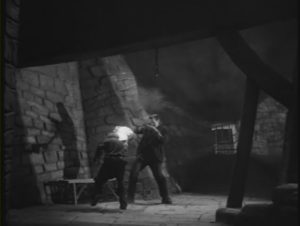 Part Five – The chaining of the Monster and his torture by Fritz and his death in the mill only occur in the movie, not the novel. Mary Shelley may have thought her story “horrifying” but it is James Whale who is actually making a “horror movie” and his connecting parts of the film to the Myth of Prometheus visually is quite brilliant. But the horror in the film comes from Whale and Balderston’s twisting of the story. In both Genesis and The Myth of Prometheus those who offend God or the gods are punished. Both tales are warnings to mankind about the dangers of offending God or the Gods, but not Frankenstein. In the film, Frankenstein gets away with it! He isn’t punished for his blasphemy, it is his monster who is chained, tortured and eventually killed. This raises a question we will explore in the next lesson; was the monster guilty or innocent?
Part Five – The chaining of the Monster and his torture by Fritz and his death in the mill only occur in the movie, not the novel. Mary Shelley may have thought her story “horrifying” but it is James Whale who is actually making a “horror movie” and his connecting parts of the film to the Myth of Prometheus visually is quite brilliant. But the horror in the film comes from Whale and Balderston’s twisting of the story. In both Genesis and The Myth of Prometheus those who offend God or the gods are punished. Both tales are warnings to mankind about the dangers of offending God or the Gods, but not Frankenstein. In the film, Frankenstein gets away with it! He isn’t punished for his blasphemy, it is his monster who is chained, tortured and eventually killed. This raises a question we will explore in the next lesson; was the monster guilty or innocent?
However, to conclude this lesson, let us return once again to James Whale’s use of light and fire as symbols in the film.
Part Six
Frankenstein’s words have a double or possibly even a triple meaning. What can he mean when he says, “Until now he has been kept in total darkness. Wait until I bring him into the light.” The literal meaning is that perhaps because his eyes need time to adjust to light, Frankenstein has kept the monster away from light, but Frankenstein’s talk about “keeping him in darkness” could be taken to mean that he has kept him without knowledge, or in ignorance, he has not tried to teach him anything yet. But his exact words are “wait until I bring him into the light”. This expression is notable. The very same expression to “bring” someone “into the light” is often used in a religious sense. It means to bring someone to an understanding of or belief in God. But let us recall that Frankenstein himself is like God to the monster. Frankenstein is his creator. Now he will be his teacher.
This is how Frankenstein sees himself, as not just the Monster’s teacher but as everyone’s teacher, the lonely genius who will teach mankind the secrets of the universe.
Students sitting and listening while teachers stand and speak is as old as…well, ancient Greece! Frankenstein asserts his authority and mastery over others by insisting they sit down. He even tells his own professor to sit down. He will explain, he will teach, he will…bring the light.
Frankenstein wants to control the Monster’s first experience with light, to “bring him into the light”. Watch again as we see how the monster reacts to light and also think about why they shut out the light.
The first part of your homework is to think about why they shut out the light? Please write your thoughts down in your notes.